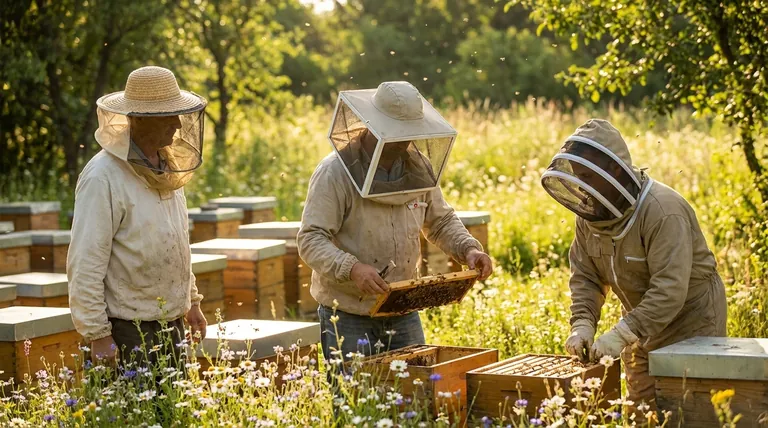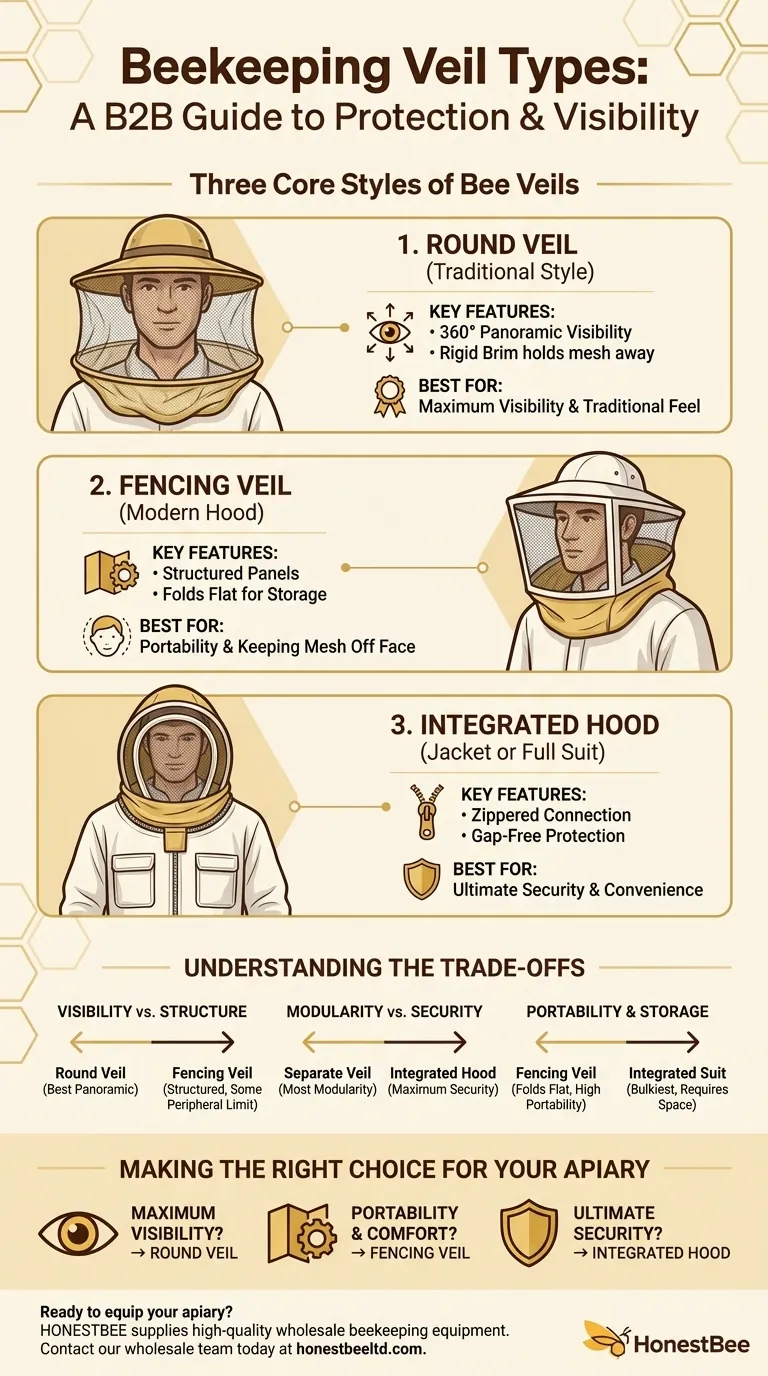To put it simply, there are three main styles of bee veils designed to protect your head and face. These categories are defined by how the veil is constructed and whether it is separate from, attached to, or fully integrated with your other protective gear like a hat, jacket, or full suit.
The choice between bee veil types is a fundamental decision that balances visibility, comfort, and the level of integrated protection you need. Understanding this trade-off is the key to selecting gear that gives you confidence while working with your hives.

The Three Core Styles of Bee Veils
Your head and face are the most critical areas to protect from stings. While all veils serve this purpose, their design directly impacts your experience, from how well you can see to how easily you can store your gear.
The Round Veil (Traditional Style)
This is the classic, wide-brimmed hat style with a veil that drapes down on all sides. The hat and veil may be permanently attached or the veil may be designed to fit over a separate hat or helmet you already own.
The rigid brim of the hat holds the mesh screen out and away from your face in all directions, offering a full 360-degree field of vision. This design is favored for its excellent visibility and traditional feel.
The Square or Fencing Veil (Modern Hood)
This modern style resembles a fencing mask and is often called a "hood" or "fencing" veil. Instead of a full brim, it has structured panels that hold the mesh away from your face at the front and sides.
The key advantage is that it often collapses or folds flat, making it much easier to store and transport. Many beekeepers also find this style keeps the mesh more consistently away from their face, especially when bending over.
The Integrated Hood (Jacket or Full Suit)
This isn't a separate piece of equipment but rather a veil—typically a Round or Fencing style—that is built directly into a beekeeping jacket or a full bee suit.
The veil attaches with a zipper, providing the most secure, gap-free connection between your head covering and your body protection. This all-in-one design offers maximum security and convenience, as you never have to worry about bees finding a gap between your veil and collar.
Understanding the Trade-offs
Choosing a veil isn't just about style; it's about evaluating the practical advantages and disadvantages of each design for your specific needs.
Visibility vs. Structure
The Round Veil offers the best panoramic visibility, which can be reassuring for new beekeepers who want to be fully aware of their surroundings.
The Fencing Veil, while offering excellent forward visibility, can have thicker corner seams or a more structured frame that slightly limits peripheral vision compared to the open design of a round veil.
Modularity vs. Security
A separate veil and hat combination offers the most modularity. You can mix and match hats or replace just the veil if it gets damaged.
An integrated hood on a jacket or suit offers maximum security. The zippered connection removes the risk of bees crawling into a gap, providing significant peace of mind, especially during more intensive hive inspections.
Portability and Storage
Fencing veils are the clear winners for portability. Most are designed to fold flat, taking up very little space in a gear bag.
Round veils can be bulky and difficult to pack without damaging the shape of the brim. Integrated suits, being the largest piece of gear, naturally require the most storage space.
Making the Right Choice for Your Goal
Your ideal veil depends entirely on your priorities as a beekeeper.
- If your primary focus is maximum visibility and a traditional feel: The Round Veil is the ideal choice, offering an unobstructed, panoramic view of your apiary.
- If your primary focus is portability and keeping mesh off your face: A Fencing Veil provides excellent protection and structure while being significantly easier to transport and store.
- If your primary focus is ultimate security and simplicity: An integrated hood on a beekeeping jacket or full suit offers the most seamless, gap-free protection.
Ultimately, the best protective gear is the gear you are comfortable wearing, allowing you to work calmly and confidently with your bees.
Summary Table:
| Veil Type | Key Feature | Best For |
|---|---|---|
| Round Veil | 360° panoramic visibility | Maximum visibility & traditional feel |
| Fencing Veil | Folds flat for easy storage | Portability & keeping mesh off face |
| Integrated Hood | Zips securely to jacket/suit | Ultimate security & gap-free protection |
Ready to equip your apiary with the right protective gear?
At HONESTBEE, we supply high-quality beekeeping supplies and equipment to commercial apiaries and distributors through our wholesale-focused operations. We understand that the right veil is critical for safety and efficiency. Let us help you find the perfect fit for your beekeepers' needs.
Contact our wholesale team today to discuss your requirements and request a catalog.
Visual Guide

Related Products
- Square Folding Bee Hat Veil with String for Beekeeping
- Heavy Duty Cowboy Beekeeper Hat with Visibility Veil Outdoor Professional Beekeeping Protective Gear
- Beekeeper Cowboy Hat and Veil for Beekeeping
- Cotton Beekeeping Suit and Round Hat with Veil Bee Keeper Protective Gear
- Yellow Plastic Bucket Pail Perch for Beekeeping
People Also Ask
- What are the different types of protective veils for beekeeping? Choose the Right Protection for Your Apiary
- What are the benefits of the lightweight fabric used in the beekeeping hat veil? Enhanced Visibility & Comfort for Hive Work
- How should the beekeeping hat veil be cleaned? The Only Safe Method to Preserve Protection
- Why is protecting the head important in beekeeping? Essential Safety for Every Beekeeper
- What is the purpose of a hat and veil in beekeeping? Essential Protection for Head & Face



















